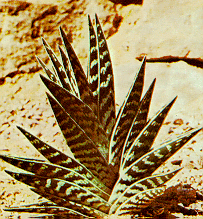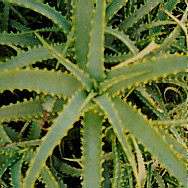Aloe
This popular group consists of about 300 succulent plants, which are found from Arabia to South Africa. These plants may grow in the form of a small, stemless rosette of fleshy leaves to a huge tree 30 feet in height. These plants have many uses; smaller varieties and hybrids make great container plants, while most are excellent for use as landscape plants in warm regions. The leaves of these succulents grow from the center of the plant and can range in length from 10 inches to 2 feet. The thick, fleshy leaves are able to store great amounts of water during a rainy season and are therefore able to survive throughout drought. Many kinds of Aloes bear pretty spikes of flowers. In winter and spring, flower stems bearing bunches of tubular-shaped flowers are produced. The long-lasting blossoms may be red, orange, green, or sometimes yellow. They are followed by small, green berries. A. variegata (Partridge-Breasted Aloe; Tiger Aloe; Kanniedood Aloe) forms a rosette, 9 inches high and 2 feet wide, of green leaves marked horizontally with white stripes. The leaves will spiral with age. In the spring, flowers ranging in color from salmon to scarlet are borne. A. dichotoma (Tree Aloe) is one of the largest species in the group. The Tree Aloe can reach a height of 30 feet. The individual rosettes, growing up to 12 inches wide, are made up of dull green leaves that are 2 inches wide and 8 inches long. In the winter, a few spikes of yellow flowers are produced. A. harlanii is a handsome variety that is suitable for growing as a houseplant. Pale green leaves, banded with dark green, grow in rosettes 7 inches in diameter. In the spring, spikes of pale pink flowers are produced. The dried juice of the leaves of several Aloes, but mainly A. vera, is commonly used to relieve some skin irritations. The leaves are broken and the oozing juice is collected in containers. Artificial heat is used to evaporate the required amount of moisture off. The residue from the leaves of A. vera is known as Barbados Aloes and Curacao Aloes. A. spicata, A. ferox and A. africana yield Cape or South African Aloes.
POTTING
These plants need a temperature of about 45 º F. Large plants will tolerate bright light about half of a day, while smaller ones should be provided with shade. These succulents can survive in poor soil conditions. They will thrive in dry air and soil with good drainage. Where climates permit, Aloes may be grown outdoors; otherwise, they may be grown in pots. Fill containers a quarter full with drainage material and compost consisting of two parts loam and one part coarse sand, broken brick and crushed limestone, with a bit of bone meal added. They should be potted in the spring and watered carefully until established. During the summer, water can be given as soon as the soil is dry, but from September to March very little is needed, just enough to prevent the leaves from shriveling. Over watering will kill your plant. Well-rooted plants will benefit from occasional applications of dilute liquid fertilizer, in the summer. Aloes don't need to be repotted often; plants in large pots will flourish for many years without being moved. Large plants, however, do need an occasional top dressing of fresh soil each spring; any loose soil should be removed and replaced with new. The drainage holes shouldn't be plugged up.
PROPAGATION
Seeds may be sown in late winter or spring in a well-drained pot containing a sandy soil mixture. Seeds and new plants need to be kept moist but not over watered. Another method is detaching suckers from around the base of the plant in the summer and placing in sandy, loamy soil. Aloes that have treelike stems can be propagated by cutting the stems just beneath a joint. Lay them on a shelf and allow a corky skin to form over the severed surface; this will discourage decay. They are then inserted into pots of sandy soil. Apply water sparingly.
VARIETIES
A. humilis;
A. barbadensis;
A. distans;
A. harlanii;
A. ramosissima;
A. plicatilis;
A. karasbergensis;
A. aristata;
A. Ecklonis;
A. striata;
A. spicata;
A. africana;
A. variegata;
A. vera.
Treelike Aloes
A. arborescens;
A. ferox;
A. Johnstonii;
A. dichotoma.






